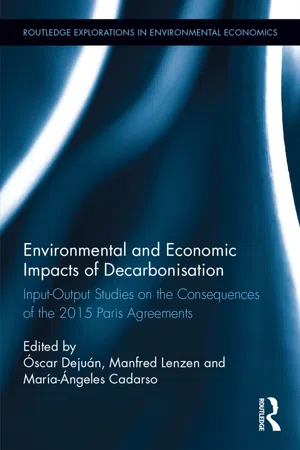![]()
Part I
Electricity generation. Towards a cleaner mix
![]()
1 Decarbonizing electricity generation in Europe
Its impact on emissions and employment all over the world
Óscar Dejuán, Jorge E. Zafrilla, María-Ángeles Tobarra, Fabio Monsalve and Carmen Córcoles
Introduction
Pollution and unemployment stand among the major economic problems and challenges of our times. On the one hand, the emission of CO2 and other greenhouse gasses (GHG) is deteriorating our current life conditions and can cause an irreversible climate change of serious consequences. The second problem refers to the difficulty in employing the existing labour force. Young people in poor countries are forced to migrate to the first world with a serious risk of social exclusion if they do not find a job. The unemployment rate of young people in rich countries is also historically high despite their having received a good education.
“Europe 2020. A Strategy for Smart, Sustainable and Inclusive Growth” was the first strategy of the European Commission to solve jointly the environmental and employment problems (EC, 2010). By 2014, the EU had cut GHG emissions by 30% compared with the 1990 baseline – faster than expected. Wind parks represented 13.2% of total installed capacity to produce electricity, which was also faster than expected (EC, 2016). But the fear of a reversal in the next boom continues to be a threat since 42% of electricity generation is still produced by burning fossil fuels. The EU was the main supporter of the decarbonization proposed in the 2015 Paris Agreement for all the sectors and countries (UN, 2015). The “Energy Roadmap” approved by the European Commission a few months later committed EU countries to reduce GHG emissions by 40% in 2030 and by 80%–95% in 2050 (EC, 2016). These goals have inspired our chapter. More concretely, we want to explore the impacts all over the world of the European replacement of fossil-electricity by wind-electricity from 2015 to 2045.
The substitution of fossil-electricity for renewable primary inputs can be analyzed from different standpoints and methodologies.1 Our approach is based on broad employment and emissions input-output multipliers. In the “multiplicand” (autonomous demand), we allocate the investment required to meet a growing permanent demand (this is the accelerator principle) and the investment required to build the wind-parks. Ours is a post-Keynesian model that emphasizes quantity changes over price changes, while technical change is embodied in investment goods.2
The computation of these broad multipliers is performed in the third section of this chapter. In section 2, we schedule the rhythm of substitution of fossil electricity for wind-electricity in the next 30 years, and we calculate the investment in wind-parks required to replace dirty fossil-electricity.
In section 4, we apply the model to figure out the impact on emissions and employment all over the world during the process of decarbonization. We analyze four possible scenarios which combine the economic rate of growth and the rhythm of substitution of fossil-electricity by wind-electricity. Our conclusions (in section 5) refer to the most probable scenario for the next 30 years – namely, an average rate of growth of 2.5%, a fast rhythm of substitution of fossil-energy by wind-electricity in the EU and a slow rhythm of substitution in the rest of the world.
Building a dynamic energy model where the mix of sources for electricity production is changing
The main source of our data comes from EXIOBASE. It is a global, multi-regional, environmentally extended input-output table (Tukker et al., 2013; Wood et al., 2015).3,4,5 It gives specific information for 48 countries/regions and 163 industries, although for our chapter, it has been aggregated to 41 sectors and 38 regions/countries – the 27 members of the European Union (EU), 7 additional major economies and 5 multi-country regions.6 The main advantage of using EXIOBASE is the detail provided for energy sectors. It considers 12 ways of generating electricity (industries 96–107), apart from its transmission and distribution (industries 108–109). The technology of electricity depends on the main source of power used in its generation: coal, gas, nuclear, hydro, wind, petroleum, biomass, solar-photovoltaic, solar-thermal, tide wave, geothermal and nec. (“not elsewhere classified”).
The purpose of this chapter is to simulate the impact of a change in the primary energy mix used to obtain electricity. More concretely, we represent the substitution of fossil-electricity by wind-electricity. This is a gradual dynamic process that obliges us to introduce a different IOT for each of the six-year periods considered: 2015–2020, 2021–2026, 2027–2032, 2033–2038 and 2039–2044. The increasing share of wind-electricity in the EU is done at the expense of fossil-electricity that diminishes 20% in points every six years. By 2045, electricity produced by burning coal, gas and petrol will be almost entirely replaced by wind-electricity. This rhythm of decarbonization refers to the EU. The rest of the world (RoW) is supposed to start later or to advance at a slower pace, as it has been the case so far.7
The process of substitution of fossil by wind-electricity requires a huge investment in wind-parks. We assume that they are produced during the six-year period that precedes year t when a change in the electricity mix is registered....
